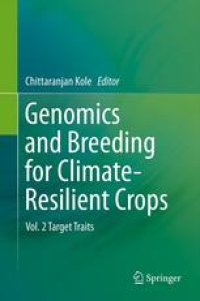
Ebook: Genomics and Breeding for Climate-Resilient Crops: Vol. 2 Target Traits
- Tags: Plant Breeding/Biotechnology, Climate Change Impacts, Agriculture, Plant Genetics & Genomics
- Year: 2013
- Publisher: Springer-Verlag Berlin Heidelberg
- Edition: 1
- Language: English
- pdf
Climate change is expected to have a drastic impact on agronomic conditions including temperature, precipitation, soil nutrients, and the incidence of disease pests, to name a few. To face this looming threat, significant progress in developing new breeding strategies has been made over the last few decades.
The second volume of Genomics and Breeding for Climate-Resilient Crops describes various genomic and breeding approaches for the genetic improvement of the major target traits. Topics covered include: flowering time; root traits; cold, heat and drought tolerance; water use efficiency; flooding and submergence tolerance; disease and insect resistance; nutrient use efficiency; nitrogen fixation; carbon sequestration; and greenhouse gas emissions.
Climate change is expected to have a drastic impact on agronomic conditions including temperature, precipitation, soil nutrients, and the incidence of disease pests, to name a few. To face this looming threat, significant progress in developing new breeding strategies has been made over the last few decades.
The second volume of Genomics and Breeding for Climate-Resilient Crops describes various genomic and breeding approaches for the genetic improvement of the major target traits. Topics covered include: flowering time; root traits; cold, heat and drought tolerance; water use efficiency; flooding and submergence tolerance; disease and insect resistance; nutrient use efficiency; nitrogen fixation; carbon sequestration; and greenhouse gas emissions.
Climate change is expected to have a drastic impact on agronomic conditions including temperature, precipitation, soil nutrients, and the incidence of disease pests, to name a few. To face this looming threat, significant progress in developing new breeding strategies has been made over the last few decades.
The second volume of Genomics and Breeding for Climate-Resilient Crops describes various genomic and breeding approaches for the genetic improvement of the major target traits. Topics covered include: flowering time; root traits; cold, heat and drought tolerance; water use efficiency; flooding and submergence tolerance; disease and insect resistance; nutrient use efficiency; nitrogen fixation; carbon sequestration; and greenhouse gas emissions.
Content:
Front Matter....Pages i-xxxviii
Flowering Time....Pages 1-66
Root Characters....Pages 67-131
Cold Tolerance....Pages 133-165
Heat Tolerance....Pages 167-202
Drought Tolerance....Pages 203-223
Water Use Efficiency....Pages 225-268
Flooding and Submergence Tolerance....Pages 269-290
Disease Resistance....Pages 291-314
Insect Resistance....Pages 315-332
Nutrient Use Efficiency....Pages 333-393
Nitrogen Fixation and Assimilation....Pages 395-413
Carbon Sequestration....Pages 415-455
Greenhouse Gas Emissions....Pages 457-474
Back Matter....Pages 475-487
Climate change is expected to have a drastic impact on agronomic conditions including temperature, precipitation, soil nutrients, and the incidence of disease pests, to name a few. To face this looming threat, significant progress in developing new breeding strategies has been made over the last few decades.
The second volume of Genomics and Breeding for Climate-Resilient Crops describes various genomic and breeding approaches for the genetic improvement of the major target traits. Topics covered include: flowering time; root traits; cold, heat and drought tolerance; water use efficiency; flooding and submergence tolerance; disease and insect resistance; nutrient use efficiency; nitrogen fixation; carbon sequestration; and greenhouse gas emissions.
Content:
Front Matter....Pages i-xxxviii
Flowering Time....Pages 1-66
Root Characters....Pages 67-131
Cold Tolerance....Pages 133-165
Heat Tolerance....Pages 167-202
Drought Tolerance....Pages 203-223
Water Use Efficiency....Pages 225-268
Flooding and Submergence Tolerance....Pages 269-290
Disease Resistance....Pages 291-314
Insect Resistance....Pages 315-332
Nutrient Use Efficiency....Pages 333-393
Nitrogen Fixation and Assimilation....Pages 395-413
Carbon Sequestration....Pages 415-455
Greenhouse Gas Emissions....Pages 457-474
Back Matter....Pages 475-487
....